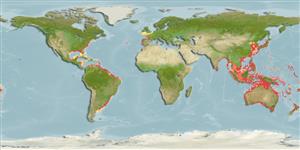Chrysaora quinquecirrha (Desor, 1848)
Sea nettle| Native range | All suitable habitat | Point map | Year 2050 |

|
| This map was computer-generated and has not yet been reviewed. |
| Chrysaora quinquecirrha AquaMaps Data sources: GBIF OBIS |
Google image |
No photo available for this species.
Classification / Names Tên thường gặp | Các synonym ( Các tên trùng) | CoL | ITIS | WoRMS
Scyphozoa | Semaeostomeae | Pelagiidae
Environment: milieu / climate zone / Mức độ sâu / distribution range Sinh thái học
Tầng nổi; Mức độ sâu 0 - 85 m (Tài liệu tham khảo 116114). Temperate
Distribution Các nước | Các khu vực của FAO | Các hệ sinh thái | Những lần xuất hiện | Những chỉ dẫn
Pacific, Atlantic and Indian Oceans.
Length at first maturity / Bộ gần gũi / Weight / Age
Chín muồi sinh dục: Lm ? range ? - ? cm Max length : 25.0 cm WD con đực/không giới tính; (Tài liệu tham khảo 2992)
Life cycle and mating behavior Chín muồi sinh dục | Sự tái sinh sản | Đẻ trứng | Eggs | Sự sinh sản | Larvae
Main reference
Các tài liệu tham khảo | Người điều phối | Người cộng tác
Calder, D.R. 1972 Tentative outline for inventory of planktonic Cnidaria: Chrysaora quinquecirrha (stinging nettle). Chesapeake Science 13 (Suppl.: Biota of the Chesapeake Bay): S179-S181. (Tài liệu tham khảo 3065)
IUCN Red List Status
(Tài liệu tham khảo 130435: Version 2025-1)
CITES status (Tài liệu tham khảo 108899)
CMS (Tài liệu tham khảo 116361)
Threat to humans
Human uses
| FishSource |
Các công cụ
Thêm thông tin
Max. ages / sizes
Length-weight rel.
Length-length rel.
Length-frequencies
Mass conversion
Sự phong phú
Các nguồn internet
BHL | BOLD Systems | CISTI | DiscoverLife | FAO(Publication : search) | Fishipedia | GenBank (genome, nucleotide) | GloBI | Gomexsi | Google Books | Google Scholar | Google | PubMed | Cây Đời sống | Wikipedia (Go, tìm) | Tạp chí Zoological Record


